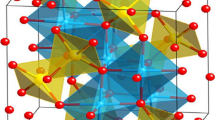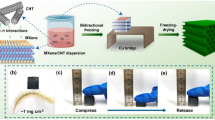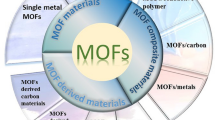Abstract
In this study, the composites of polyaniline (PANI) and aniline-terminated silica (M-SiO2), as supercapacitor electrodes, were prepared by a facile method of mechanical agitation combined with sonication. The obtained PANI/M-SiO2 composites were analyzed using Fourier transform infrared spectroscopy (FTIR), scanning electron microscopy (SEM), X-ray diffraction (XRD), cyclic voltammetry (CV), galvanostatic charge–discharge (GCD), and electrochemical impedance spectroscopy (EIS) measurements. Compared with PANI, PANI/M-SiO2 exhibited a maximum specific capacitance of 307.5 F/g by GCD test at 1 A/g with a potential range of 0–0.8 V. PANI/M-SiO2 retained approximately 93% of its capacitance after 500 cycles of charge–discharge at 8 A/g, whereas pure PANI retained only 70%. The excellent electrochemical performances of the PANI/M-SiO2 composites were attributed to the synergetic interaction between the PANI and M-SiO2 nanoparticles.








Similar content being viewed by others
References
Xia X, Tu J, Zhang Y, Wang X, Gu C, Zhao X, Fan H (2012) High-quality metal oxide core/shell nanowire arrays on conductive substrates for electrochemical energy storage. ACS Nano 6(6):5531–5538. https://doi.org/10.1021/nn301454q
Conway B (1991) Transition from “supercapacitor” to “battery” behavior in electrochemical energy storage. J Electrochem Soc 138(6):1539–1548. https://doi.org/10.1149/1.2085829
Saghafi M, Mahboubi F, Mohajerzadeh S, Holze R (2015) Preparation of Co-Ni oxide/vertically aligned carbon nanotube and their electrochemical performance in supercapacitors. Mater Manuf Process 30(1):70–78. https://doi.org/10.1080/10426914.2014.952026
Kang E, Neoh K, Tan K (1998) Polyaniline: a polymer with many interesting intrinsic redox states. Prog Polym Sci 23(2):277–324. https://doi.org/10.1016/S0079-6700(97)00030-0
Gordana C (2013) Recent advances in polyaniline research: polymerization mechanisms, structural aspects, properties and applications. Synth Met 177:1–47
Anand J, Palaniappan S, Sathyanarayana D (1998) Conducting polyaniline blends and composites. Prog Polym Sci 23(6):993–1018. https://doi.org/10.1016/S0079-6700(97)00040-3
Jiang J, Li Y, Liu J, Huang X, Yuan C, Lou X (2012) Recent advances in metal oxide-based electrode architecture Design for Electrochemical Energy Storage. Adv Mater 24(38):5166–5180. https://doi.org/10.1002/adma.201202146
Cao S, Han N, Han J, Hu Y, Fan L, Zhou C, Guo R (2016) Mesoporous hybrid shells of carbonized polyaniline/Mn2O3 as non-precious efficient oxygen reduction reaction catalyst. ACS Appl Mater Interfaces 8(9):6040–6050. https://doi.org/10.1021/acsami.5b11955
Zhang H, Zong R, Zhao J, Zhu Y (2008) Dramatic visible photocatalytic degradation performances due to synergetic effect of TiO2 with PANI. Environ Sci Technol 42(10):3803–3807. https://doi.org/10.1021/es703037x
Xing J, Zhang W, Yin M, Zhu X, Li D, Song Y (2017) Electrodeposition of polyaniline in long TiO2 nanotube arrays for high-areal capacitance supercapacitor electrodes. J Solid State Electrochem 21(8):2349–2354. https://doi.org/10.1007/s10008-017-3588-1
Benykhlef S, Bekhoukh A, Berenguer R, Benyoucef A, Morallon E (2016) PANI-derived polymer/Al2O3 nanocomposites: synthesis, characterization, and electrochemical studies. Colloid Polym Sci 294(12):1877–1885. https://doi.org/10.1007/s00396-016-3955-y
Frackowiak E, Khomenko V, Jurewicz K, Lota K, Béguin F (2006) Supercapacitors based on conducting polymers/nanotubes composites. J Power Sources 153(2):413–418. https://doi.org/10.1016/j.jpowsour.2005.05.030
Fan L, Hu Y, Maier J, Adelhelm P, Smarsly B, Antonietti M (2007) High electroactivity of polyaniline in supercapacitors by using a hierarchically porous carbon monolith as a support. Adv Funct Mater 17(16):3083–3087. https://doi.org/10.1002/adfm.200700518
Wang Y, Li H, Xia Y (2006) Ordered whiskerlike polyaniline grown on the surface of mesoporous carbon and its electrochemical capacitance performance. Adv Mater 18(19):2619–2623. https://doi.org/10.1002/adma.200600445
Zhang K, Zhang L, Zhao X, Wu J (2010) Graphene/polyaniline nanofiber composites as supercapacitor electrodes. Chem Mater 22(4):1392–1401. https://doi.org/10.1021/cm902876u
Wang D, Li F, Zhao J, Ren W, Chen Z, Tan J, Wu Z, Gentle I, Lu G, Cheng H (2009) Fabrication of graphene/polyaniline composite paper via in situ anodic electropolymerization for high-performance flexible electrode. ACS Nano 3(7):1745–1752. https://doi.org/10.1021/nn900297m
Xu J, Wang K, Zu S, Han B, Wei Z (2010) Hierarchical nanocomposites of polyaniline nanowire arrays on graphene oxide sheets with synergistic effect for energy storage. ACS Nano 4(9):5019–5026. https://doi.org/10.1021/nn1006539
Zhu X, Xie T, Mo Z, Zhao G, Zhang C, Guo R (2015) Fabrication of polyaniline/graphene/Tb3+ conductive composite material. Mater Manuf Process 30(3):335–339. https://doi.org/10.1080/10426914.2014.973581
Weng C, Chen Y, Chien C, Dai C (2013) Preparation of gold decorated SiO2@polyaniline core-shell microspheres and application as a sensor for ascorbic acid. Electrochim Acta 95:162–169. https://doi.org/10.1016/j.electacta.2013.01.150
Liu X, Dou Y, Wu J, Peng X (2008) Chemical anchoring of silica nanoparticles onto polyaniline chains via electro-co-polymerization of aniline and N-substituted aniline grafted on surfaces of SiO2. Electrochim Acta 53(14):4693–4698. https://doi.org/10.1016/j.electacta.2008.01.064
Babazadeh M, Zalloi F, Olad A (2015) Fabrication of conductive polyaniline nanocomposites based on silica nanoparticles via in-situ chemical oxidative polymerization technique. Synth React Inorg Met 45(1):86–91. https://doi.org/10.1080/15533174.2013.818687
Cai J, Zuo P, Cheng X, Xu Y, Yin G (2010) Nano-silicon/polyaniline composite for lithium storage. Electrochem Commun 12(11):1572–1575. https://doi.org/10.1016/j.elecom.2010.08.036
Wei H, Gu H, Guo J, Wei S, Liu J, Guo Z (2013) Silica doped nanopolyaniline with endured electrochemical energy storage and the magnetic field effects. J Phys Chem C 117(25):13000–13010. https://doi.org/10.1021/jp403656q
Sasidharan M, Mal N, Bhaumik A (2007) In-situ polymerization of grafted aniline in the channels of mesoporous silica SBA-15. J Mater Chem 17(3):278–283. https://doi.org/10.1039/B610392H
Han H, Gong X (2014) Effect of fiber surface modification with different functional groups silane agents on mechanical properties of hemps/polypropylene composites. Appl Mech Mater 470:23–26
Chang K, Hsu C, Peng C, Huang Y, Yeh J, Wan H, Hung W (2014) Preparation and comparative properties of membranes based on PANI and three inorganic fillers. Express Polym Lett 8(3):207–218. https://doi.org/10.3144/expresspolymlett.2014.24
Lin W, Xu K, Xin M, Peng J, Xing Y, Chen M (2014) Hierarchical porous polyaniline-silsesquioxane conjugated hybrids with enhanced electrochemical capacitance. RSC Adv 4(74):39508–39518. https://doi.org/10.1039/C4RA04422C
Bhadra S, Khastgir D, Singha N, Lee J (2009) Progress in preparation, processing and applications of polyaniline. Prog Polym Sci 34(8):783–810. https://doi.org/10.1016/j.progpolymsci.2009.04.003
Wu T, Lin Y, Liao C (2005) Preparation and characterization of polyaniline/multi-walled carbon nanotube composites. Carbon 43(4):734–740. https://doi.org/10.1016/j.carbon.2004.10.043
Jiao S, Tu J, Fan C, Hou J, Fray D (2011) Electrochemically assembling of a porous nano-polyaniline network in a reverse micelle and its application in a supercapacitor. J Mater Chem 21(25):9027–9030. https://doi.org/10.1039/c1jm11064k
Ge D, Yang L, Tong Z, Ding Y, Xin W, Zhao J, Li Y (2013) Ion diffusion and optical switching performance of 3D ordered nanostructured polyaniline films for advanced electrochemical/electrochromic devices. Electrochim Acta 104:191–197. https://doi.org/10.1016/j.electacta.2013.04.102
Li Y, Zhang Q, Zhao X, Yu P, Wu L, Chen D (2012) Enhanced electrochemical performance of polyaniline/sulfonated polyhedral oligosilsesquioxane nanocomposites with porous and ordered hierarchical nanostructure. J Mater Chem 22(5):1884–1892. https://doi.org/10.1039/C1JM13359D
Wu W, Pan D, Li Y, Zhao G, Jing L, Chen S (2015) Facile fabrication of polyaniline nanotubes using the self-assembly behavior based on the hydrogen bonding: a mechanistic study and application in high-performance electrochemical supercapacitor electrode. Electrochim Acta 152:126–134. https://doi.org/10.1016/j.electacta.2014.11.130
Tang L, Yang Z, Duan F, Chen M (2017) Hierarchical architecture of ultrashort carbon nanotubes/polyaniline nanocables coated on graphene sheets for advanced supercapacitors. J Mater Sci Mater Electron 28(21):15804–15818. https://doi.org/10.1007/s10854-017-7475-4
Tang L, Duan F, Chen M (2016) Fabrication of ferric chloride doped polyaniline/multilayer super-short carbon nanotube nanocomposites for supercapacitor applications. J Solid State Electrochem 20(10):2805–2816. https://doi.org/10.1007/s10008-016-3264-x
Funding
This study was supported by the National Natural Science Foundation of China (grant numbers 21401079, 21501069); Fundamental Research Funds for the Central Universities (grant number JUSRP51626B); the Natural Science Foundation of Jiangsu Province of China (grant numbers BK20140158, BK20161128 and BK20161166); the Research Project of Xuzhou (grant number KC15SM038); and the Top-notch Academic Programs Project of Jiangsu Higher Education Institutions (grant number PPZY2015B181).
Author information
Authors and Affiliations
Corresponding authors
Rights and permissions
About this article
Cite this article
Li, P., Ni, C., Shi, G. et al. Fabricating composite supercapacitor electrodes of polyaniline and aniline-terminated silica by mechanical agitation and sonication. J Solid State Electrochem 22, 1249–1256 (2018). https://doi.org/10.1007/s10008-017-3870-2
Received:
Revised:
Accepted:
Published:
Issue Date:
DOI: https://doi.org/10.1007/s10008-017-3870-2




